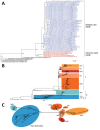Highly Pathogenic Avian Influenza A(H5N8) Virus in Wild Migratory Birds, Qinghai Lake, China
- PMID: 28169827
- PMCID: PMC5367427
- DOI: 10.3201/eid2304.161866
Highly Pathogenic Avian Influenza A(H5N8) Virus in Wild Migratory Birds, Qinghai Lake, China
Abstract
In May 2016, a highly pathogenic avian influenza A(H5N8) virus strain caused deaths among 3 species of wild migratory birds in Qinghai Lake, China. Genetic analysis showed that the novel reassortant virus belongs to group B H5N8 viruses and that the reassortment events likely occurred in early 2016.
Keywords: China; H5N8; HPAI; Highly pathogenic avian influenza virus; Qinghai Lake; bird diseases; influenza; influenza in birds; phylogenetic analysis; reassortment; viruses; wild aquatic birds; wild migratory birds.
Figures


References
-
- World Health Organization/World Organisation for Animal Health/Food and Agriculture Organization (WHO/OIE/FAO) H5N1 Evolution Working Group. Revised and updated nomenclature for highly pathogenic avian influenza A (H5N1) viruses. Influenza Other Respi Viruses. 2014;8:384–8. 10.1111/irv.12230 - DOI - PMC - PubMed
-
- World Organisation For Animal Health. Updated on highly pathogenic avian influenza in animals (type H5 and H7), 2014–2015. Paris: The Organisation; 2015.
MeSH terms
LinkOut - more resources
Full Text Sources
Other Literature Sources
Medical

